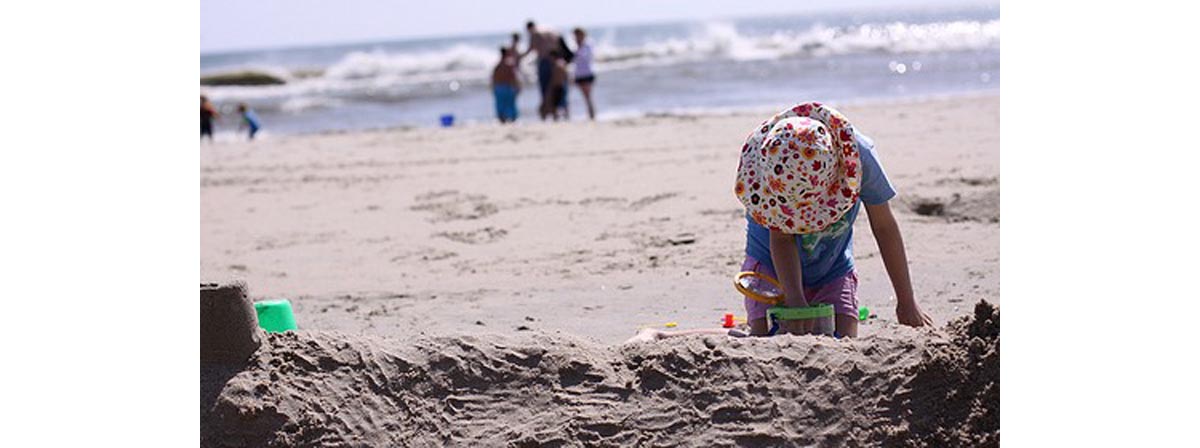Table of Contents
Sand flea bites don't have to ruin your family's tropical beach vacation if you take these simple steps.

1. Sand fleas show a preference for biting children who have not reached the age of six and adults who have passed the age of sixty.
The youngest and oldest members of your family need the most protection against sand flea bites.
2. Putting your toes in the sand gives biting insects their greatest opportunity.
Most people who get sand flea bites get them between their toes. Wearing shoes, rather than going barefoot or wearing sandals, offers good protection against the fleas. If you like to wander the beach nude, be sure to put down a blanket or at least a towel before you sit down on the sand. The fleas are fond of those areas of your body, too.
3. A product called Zanzarin can prevent sand flea bites even if you don't wear shoes.
Zanzarin is a mixture of jojoba oil, coconut oil, and aloe vera gel. Scientists at the Charité Medical School, Campus Benjamin Franklin in Berlin have confirmed that it reduces the number of sand flea bites by 81 to 100% and clears up 87 to 98% of existing bites, all with no toxic side effects. Zanzarin works by forming a sticky barrier on the skin that the female sand flea cannot penetrate to make her bite, and by suffocating sand fleas that have already lodged into the skin, encouraging those that have just started burrowing into the skin to jump off.
As long as the product is used before sand fleas bite or within 1 or 2 days of sand flea bites, it is highly effective. Just about the only problem with this product is that it is not marketed in the United States. American travelers must either find it at their vacation locations or buy the three natural products at home and take them in their luggage. Apply the products in any order and rub onto the skin.
4. Your doctor may prescribe a medication called ivermectin if you ask for help with sand flea problems.
If the name ivermectin sounds familiar, it's probably because you have bought it from your veterinarian for controlling fleas on your pets. Clinical studies of the use of ivermectin for the control of sand fleas in human beings have not been particularly encouraging.
5. However, doctors in the USA seldom diagnose sand fleas unless they have extensive experience working in the tropics.
The US Centers for Disease Control only locates reports of about 20 cases of sand flea bites per year. That's probably because very few Americans see their doctors for treatment of sand flea problems.
6. A medication called niridazole (marketed under the trade name Ambilhar) is very effective for killing sand fleas imbedded under the skin in children.
Unfortunately, this product is also only available outside the USA, although the problem is that the drug manufacturer has not registered it, not that it has toxic side effects.
7. If you take a look at a sand flea bite under a magnifying glass, you will detect a characteristic pattern not immediately visible by simple inspection of the skin.
When you are trying to distinguish a sand flea bite from other kinds of insect bites, such as bites from other kinds of fleas, tick bites, fire ant bites, or scabies, take a look at the bite through a magnifying lens. The area of inflammation, after the first two days, will begin to turn brown. It will spread asymetrically, one side larger than the other. The center of the bite will be bluish-black, and it may even be possible to see tiny sand flea eggs lodged on the skin.
- Caumes E, Carrière J, Guermonprez G, Bricaire F, Danis M, Gentilini M. Dermatoses associated with travel to tropical countries: a prospective study of the diagnosis and management of 269 patients presenting to a tropical disease unit. Clin Infect Dis. Mar 1995. 20(3):542-8.
- Feldmeier H, Kehr JD, Heukelbach J. A plant-based repellent protects against Tunga penetrans infestation and sand flea disease. Acta Trop. 2006 Oct. 99(2-3):126-36. Epub 2006 Sep 29.
- Photo courtesy of Julio Reis by Wikimedia Commons: commons.wikimedia.org/wiki/File:Talitrus_saltator_Aguda.jpg
- Photo courtesy of Jessica Lucia by Flickr : www.flickr.com/photos/theloushe/3786553631/

